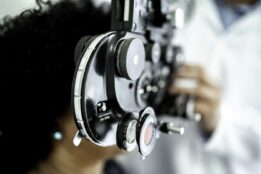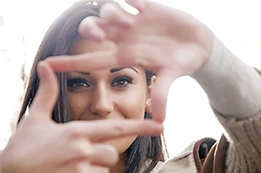LASIK Dry Eyes: Understanding Dry Eyes After LASIK

Dry eye is extremely common and is, in fact, the most common reason patients visit an eye doctor’s office. You may have heard that some patients may also have dry eye symptoms after LASIK. It is true that during the healing process, some LASIK patients may experience dry eye symptoms. But only some patients, and usually for a short while. Some patients don’t.
Dry Eyes After LASIK?
A few may have dry eyes for up to a year as the surface of the eye heals. To help with the healing process and to keep patients comfortable, eye drops are prescribed to all LASIK patients.
Because dry eye can be caused by many different conditions, it is important to understand dry eye symptoms in the context of having LASIK. The fact is many people who want LASIK already have dry eyes. Recent research reports that up to 30 percent of laser vision correction patients report dry eye symptoms prior to surgery. This isn’t surprising because many contact lens wearers complain about uncomfortable dry eyes as a result of using contacts. Those patients often look into having LASIK so they can continue to see well without having to resort to wearing glasses when their contacts are no longer tolerated.
There have been a lot of advances in the field, both in diagnosing dry eyes, as well as treating them. An important part of the evaluation for LASIK candidacy is assessing any dry eye symptoms and their potential impacts to the surface of the eye, because about 50 percent of LASIK candidates have some clinical signs of dry eye prior to surgery. If dry eye is diagnosed before LASIK, the patient can have their pre-existing dry eye problem treated. Pre-existing dry eye is the leading risk factor for significant dry eye after LASIK, so it is important to discuss any dry eye symptoms during the LASIK evaluation. Once the dry eye is resolved and the surface of the eye is in good condition, patients can often move forward successfully with LASIK.
Why Does LASIK Cause Dry Eyes?
All surgeries involve cutting tissue. In the case of LASIK, some nerves in the cornea are cut which can temporarily reduce the sensation – the awareness or feeling – you have of the surface of the eye. During the healing process, the eye may not sense the need for moisture, so it produces fewer tears which can lead to dry eye symptoms. Because LASIK changes the shape of the cornea, it is also possible that, while the eye heals, the tear film is unevenly distributed across the surface of the eye. When the surface of the eye is dry it doesn’t do as good of a job in focusing light, causing blurry vision. This is why it is important to keep up the eye drop routine prescribed by the eye surgeon, which includes both lubricating eye drops and other medication to help with healing. The good news is that for the vast majority of LASIK patients, dry eye symptoms are mild and temporary and, with today’s advanced dry eye therapies, can be well-managed.
How Likely are LASIK Dry Eyes?
Recently, the FDA led a study designed to develop and validate a survey for patients to scientifically report their overall experience with LASIK. This included how and how often patients reported experiencing dry eye symptoms before and after LASIK. The findings of the FDA patient-reported outcomes with LASIK study were particularly interesting when it came to dry eye symptoms:
- For those who reported having dry eye symptoms before LASIK, nearly 60 percent reported their symptoms resolved after having LASIK.
- Less than 30 percent of patients with no symptoms before LASIK reported having dry eye symptoms after LASIK. The majority – 85 percent – reported the symptoms were mild.
- Regardless of whether or not they had dry eye symptoms before LASIK, patients reporting dry eye symptoms after LASIK continued to see improvement in their symptoms over time.
Importantly, having dry eyes does not automatically eliminate you as a candidate for LASIK or other laser vision correction procedures. Your eye doctor will need to thoroughly evaluate your condition and discuss treatment with you before recommending a procedure. You should feel comfortable asking your eye doctor about the potential of dry eye symptoms after LASIK, so you have an informed understanding of what to expect. This should include talking about what therapies might be recommended to keep you comfortable during the healing process.




